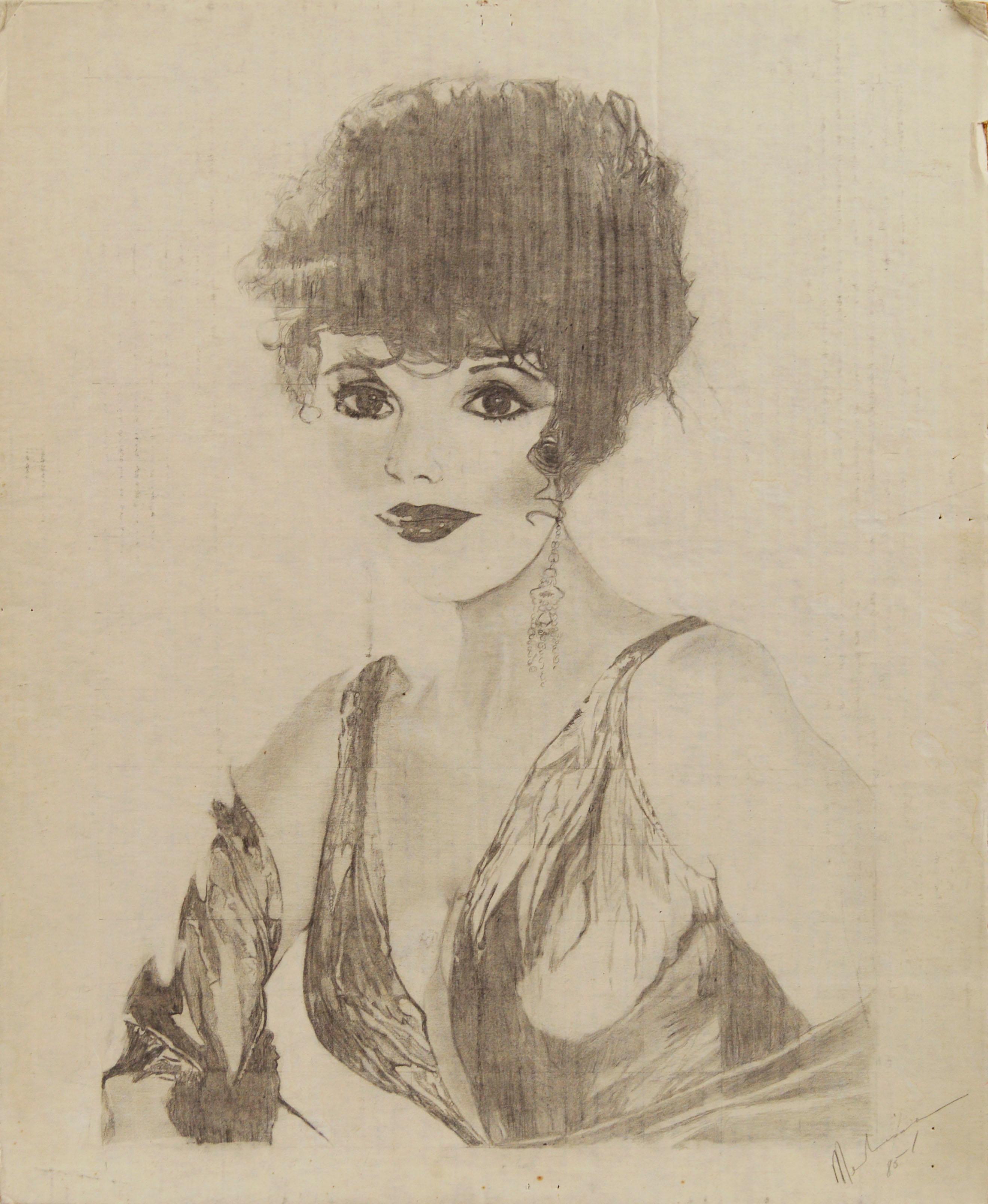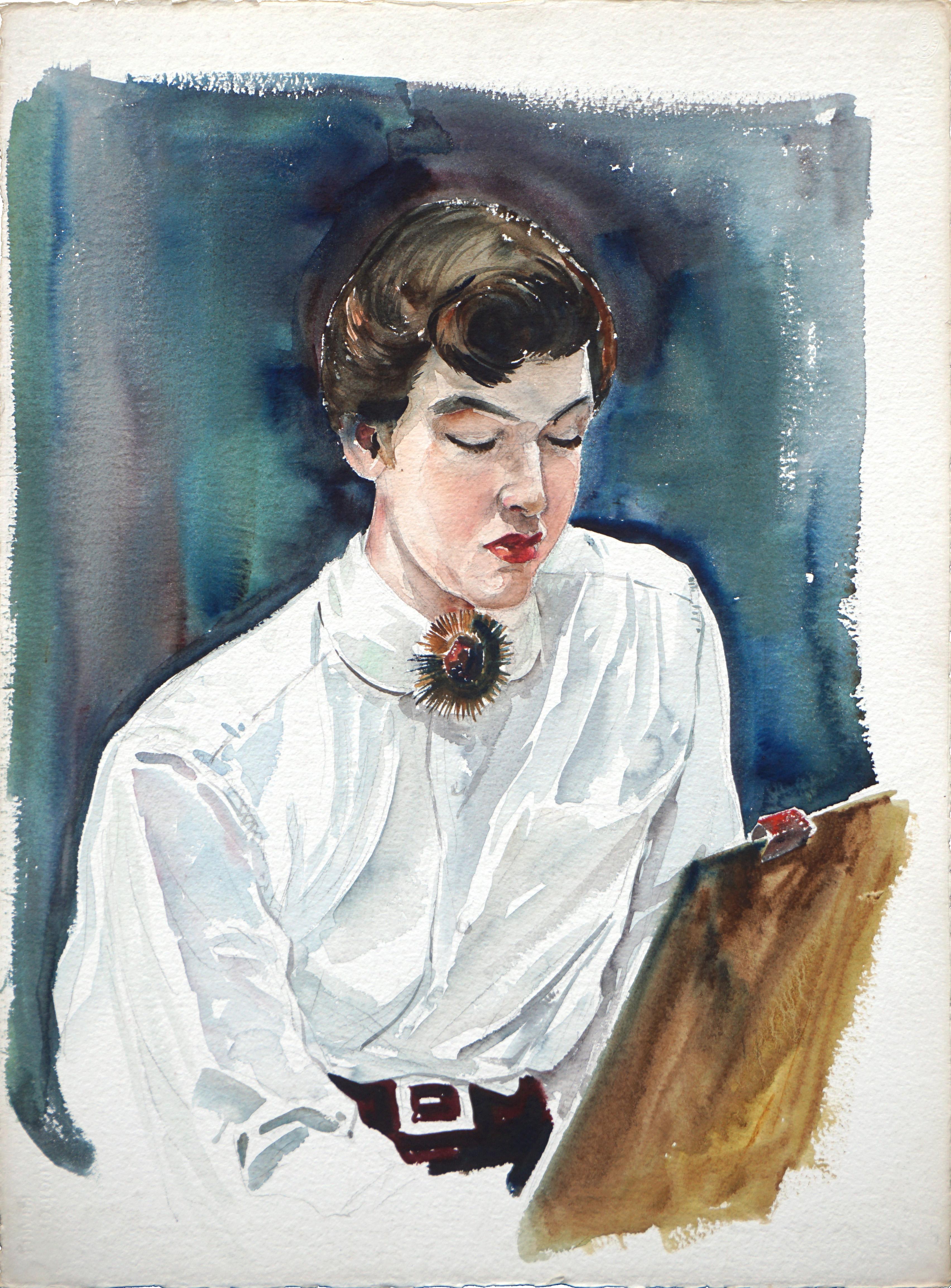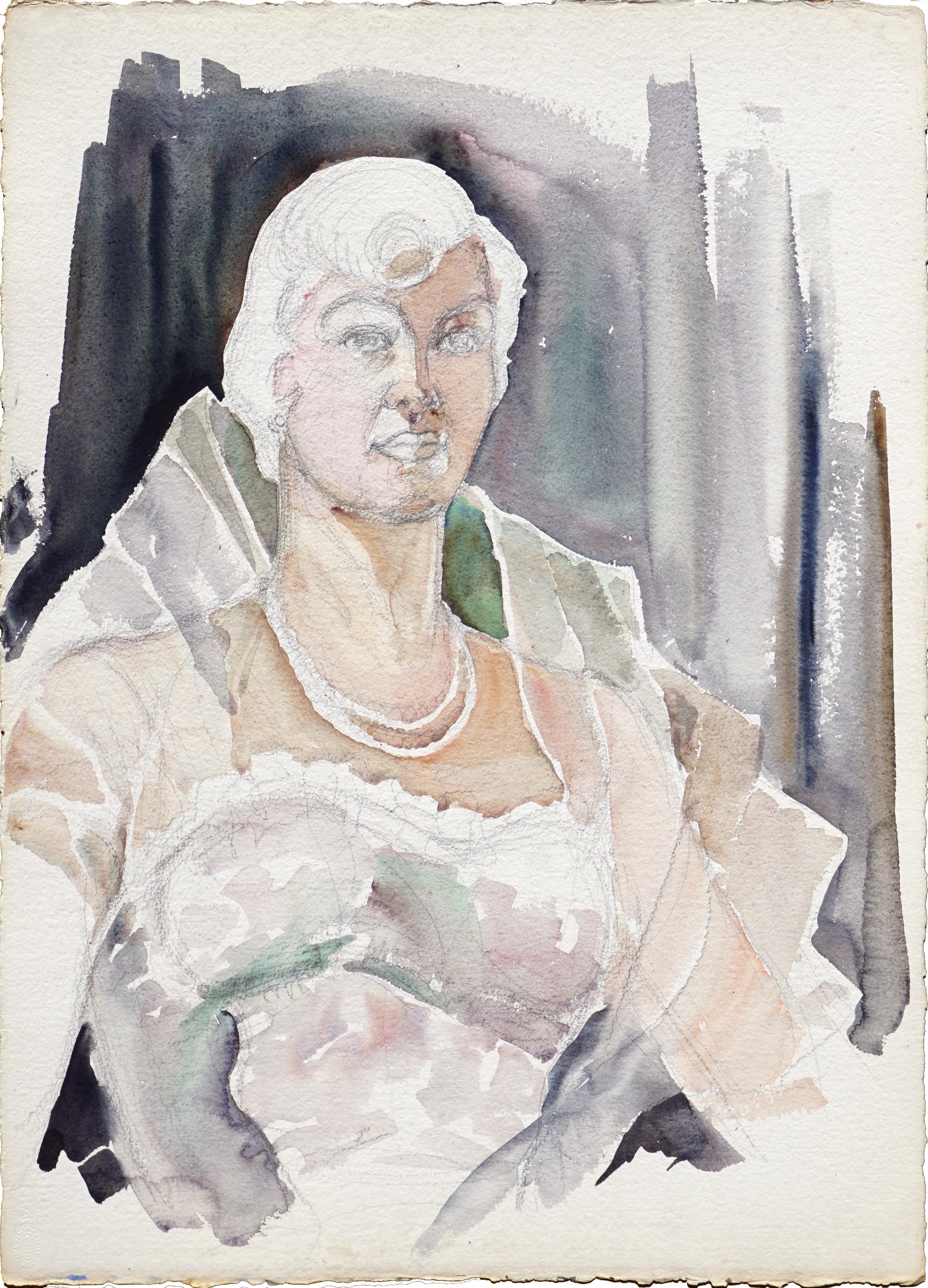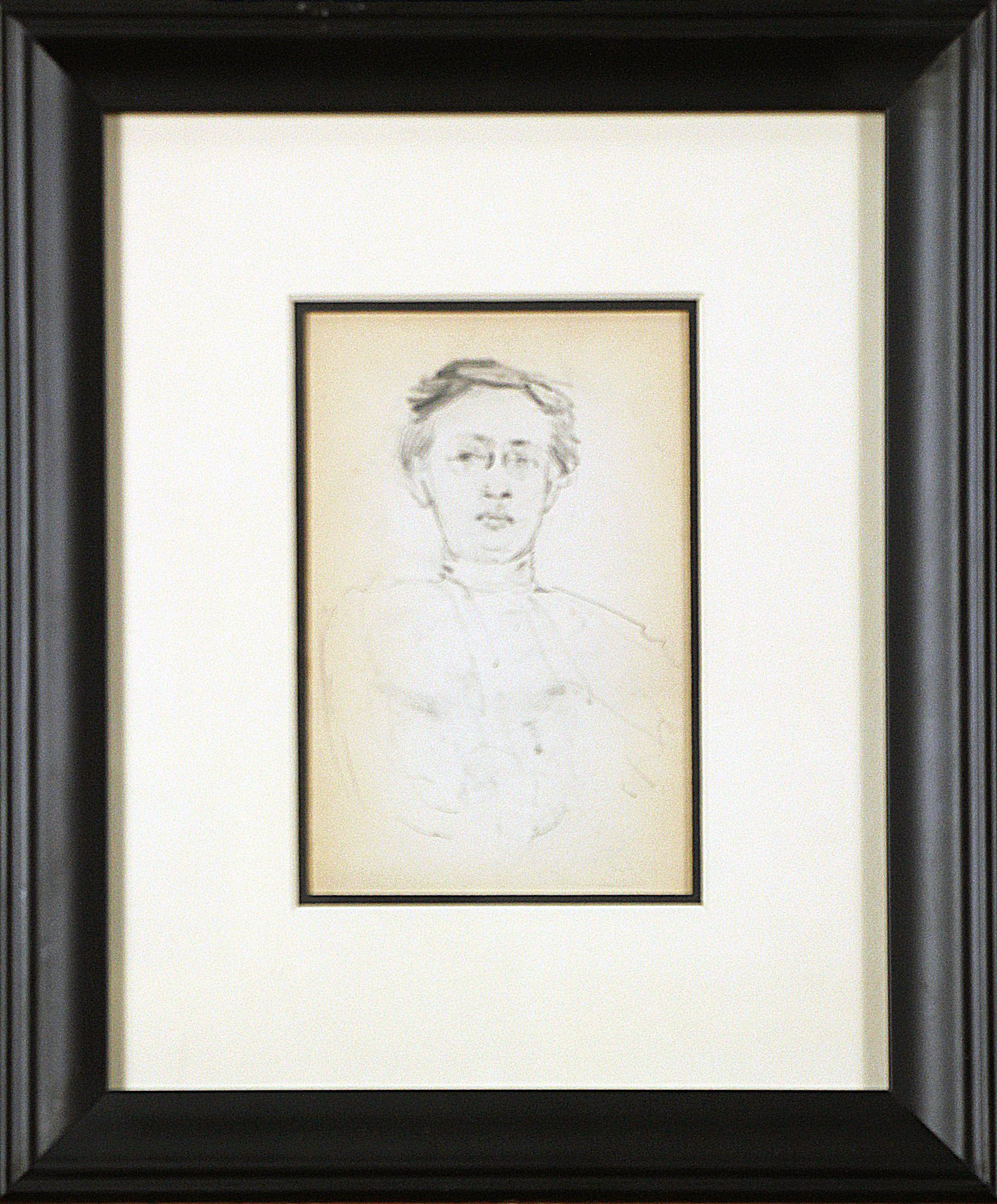Items Similar to Young Lady in Profile
Want more images or videos?
Request additional images or videos from the seller
1 of 8
Harrison M. FisherYoung Lady in Profilec. 1915
c. 1915
About the Item
Young Lady in Profile (Dorothy Gibson)
Graphite on paper, c. 1915
Signed lower right (see photo).
The sitter for this drawing, along with a huge number of Harrison Fisher’s works, is the model, turned actress, Miss Dorothy Winifred Gibson (1889-1946).
She was one of the lucky ones who survived the sinking of the Titanic in 1912. There is an in depth biographical sketch available on Wiki.
"Dorothy Winifred Gibson (1889-1946) is arguably one of the most fascinating women of the twentieth century. Her story is more than deserving of its own film or TV show and yet, if it was to ever appear on the screen, it would be in serious danger of being criticised as ‘too unbelievable’ or ‘farfetched’. But believe me, readers, everything I am about to tell you about Dorothy Gibson is true...
Early Life
Dorothy Winifred Gibson (originally Dorothy Winifred Brown, before her father died when she was three years old and her mother remarried), was born in New Jersey on 17 May 1889. Between 1906 and 1911 (aged 17-22), she appeared on stage as a singer and dancer in a number of theatre and vaudeville productions, and in 1909 she began modelling for Harrison Fisher, a famous commercial artist. Dorothy soon became Fisher’s favourite muse, and her image was seen regularly on postcards, merchandising products and even on the covers of magazines like Cosmopolitan. During this time, Dorothy met and married a pharmacist named George Henry Battier Jr, but the couple soon separated and were divorced by 1913.
As early as 1911, Dorothy began appearing in movies, starting out as an extra but soon taking the leading roles in a series of films by Éclair Studios. Praised for her natural acting style and comedic flair, she was a huge hit – and arguably the first actress to be promoted as a star in her own right.
Surviving the sinking of the RMS Titanic
On 17 March 1912, after starring in a string of movies, Dorothy and her mother, Pauline, took a trip to Europe – but after a few weeks Dorothy was called back to America by the studio to start working on a new series of films. Dorothy and her mother were in Paris when they booked their tickets on the maiden voyage of the RMS Titanic, and boarded at Cherbourg on 10th April.
On the night the ship sank, Dorothy had ‘spent a pleasant Sunday evening playing bridge with a couple of friendly New York bankers’ (her words, in an interview with the New York Dramatic Mirror). Despite the request of a steward for them to finish, they carried on with their game and it was not until about 11:40pm that Dorothy returned to the stateroom she shared with her mother. It was at that point that she felt ‘a long drawn, sickening crunch’ and, while not exactly alarmed, she decided nonetheless to investigate. Quickly noticing that the deck was ‘lopsided’, she rushed back to her room to fetch her mother, and the pair returned to the boat deck. Dorothy and her mother escaped from the ship on the first lifeboat launched (number 7), and given how quiet it was on the boat deck at the time, she asked her bridge partners to join them.
However, events took a turn for the worst when a hole was found in the bottom of the lifeboat, causing icy cold water to rush in and almost flood the boat. Luckily, though, Dorothy explained, ‘this was remedied by volunteer contributions from the lingerie of the women and the garments of men.’
It is hard for us now to imagine the terrors of that night – and the emotional damage it caused to those who survived. After the event, Dorothy told the Moving Picture World, ‘I will never forget the terrible cry that rang out from people who were thrown into the sea and others who were afraid for their loved ones.’ Unbelievably, though, Dorothy was to re-enact the experience a mere five days after it happened, when she starred in the first film about the disaster. It was a silent movie, called Saved From The Titanic, and was actually hugely successful and the first of many hit films about the sinking. In the movie, Dorothy even wore the same clothes she had been wearing when the ship sank – a white silk dress underneath a cardigan and polo coat.
Shortly after the release of Saved from the Titanic Dorothy gave up acting.
An affair to remember
At the same time as her movie career was taking off, Dorothy began a six-year affair with one of the studio’s producers, the married movie tycoon Jules Brulatour who was 19 years her senior. In fact, it was Brulatour who told Dorothy to cut her European trip short and return to America to make a new series of films. He was also one of the producers on Saved from the Titanic, so we can assume he was at least partially responsible for Dorothy having to relive the nightmare so soon after it happened.
The affair was made public in 1913, when Dorothy accidentally struck and killed a man while driving Brulatour’s car. During the court case that followed, the press learned that Dorothy was Brulatour’s mistress and, although he and his wife had already separated, the humiliation of the whole thing caused Mrs Brulatour to sue him for divorce. This was finalised in 1915 and, in order to preserve his reputation, Brulatour married Dorothy in 1917.
However, the marriage was short-lived, and within two years the couple had separated. The more sceptical might argue that perhaps the marriage failed because it lacked the spark and excitement it had had when it was a secret (or, perhaps, because of a little thing called karma), but the original Mrs Brulatour also played a role in destroying the relationship that had helped to ruin hers. Indeed, Brulatour’s marriage to Dorothy infuriated her, and she started proceedings against him claiming the union was illegal, since he had obtained a divorce in Kentucky instead of New York (where he had residency). This was a long, drawn-out and complicated affair, the stress of which undoubtedly took its toll on the marriage, and it was ultimately dissolved as an invalid contract in 1919.
While Brulatour went on to marry actress Hope Hampton in 1923, Dorothy never remarried. Humiliated, she left New York for Paris, in the hopes of a fresh start and a quiet life with her mother. But Dorothy’s story doesn’t end there…
Surviving a Nazi prison
Although Dorothy’s story is by no means over when she departs America for France, the details do become a little bit more hazy. A more sympathetic account is that, when the Second World War broke out in 1939, Dorothy and her mother were actually in Florence (as they tended to split their time between Florence and Paris), and didn’t return to the relative safety of America because their ordeal on board the RMS Titanic had scarred them so. According to Dorothy, ‘I must say I never wanted to make the ocean trip to America at this time, as my mother and I were most timid on the ocean—we had been in a shipwreck—but I also never wanted to stay in Italy, but we just waited in Italy always hoping things would be better to travel.’ Following this narrative, Dorothy and her mother essentially found themselves trapped in Nazi-occupied territory, but other accounts would suggest that the decision to remain was made willingly, because the pair (led by Dorothy’s mother) had actually become Fascist sympathisers and potentially even Nazi spies.
By the spring of 1944, Dorothy had renounced her sympathies (if, indeed, she had any to begin with), but soon after was arrested as an anti-Fascist agitator and jailed in the Milan prison of San Vittore, which she described as a ‘living death’. Chances are, Dorothy would have died in that prison, were it not for the help of a double agent, Ugo Luca Osteria (‘Dr. Ugo’) who helped to smuggle her out of the prison under the pretence that she was a Nazi sympathiser and spy (I’ll leave it up to you to determine how much ‘pretence’ was needed!) The plan worked, and Dorothy escaped to Switzerland, where she was interrogated by James G. Bell, vice consul of the American consulate general. Once again, sources disagree; some say the allied authorities were never able to determine if she was a real Nazi spy, or just pretending, while others say the interrogation was more conclusive, with Bell actually deeming her ‘too stupid’ to be a spy. Either way, Dorothy was free.
Death
After the war, Dorothy returned to Paris, but the trauma of surviving both the sinking of the Titanic and a Nazi prison camp had taken its toll. She died a few months later in her hotel room, presumably of a heart attack. She was 56 years old. Her mother outlived her by 15 years and, as she grew older, grew increasingly vocal in her criticism of the Allies and in her pro-Nazi statements – which can either suggest that Dorothy herself was unfairly tarred with the same brush, or that perhaps Dorothy really did share these views, depending on which way you want to look at it."
Courtesy Holly Hewilett
Provenance:
H. Frederic Gough
- Creator:Harrison M. Fisher (1875-1934, American)
- Creation Year:c. 1915
- Dimensions:Height: 18 in (45.72 cm)Width: 14 in (35.56 cm)
- Medium:
- Movement & Style:
- Period:
- Condition:Original Condition.
- Gallery Location:Fairlawn, OH
- Reference Number:
About the Seller
5.0
Recognized Seller
These prestigious sellers are industry leaders and represent the highest echelon for item quality and design.
Platinum Seller
These expertly vetted sellers are 1stDibs' most experienced sellers and are rated highest by our customers.
Established in 1978
1stDibs seller since 2013
712 sales on 1stDibs
Typical response time: 1 hour
Associations
International Fine Print Dealers Association
- ShippingRetrieving quote...Ships From: Fairlawn , OH
- Return PolicyA return for this item may be initiated within 10 days of delivery.
More From This SellerView All
- Study of Lucie (Ralph) Belin seated in an interiorBy Edouard VuillardLocated in Fairlawn, OHStudy of Lucie (Ralph) Belin seated in an interior Graphite on paper, 1915 Signed with the estate stamp, Lugt 909b, the stamp faded from blue to brown (see photo) Provenance: Neffe-D...Category
1910s Impressionist Portrait Drawings and Watercolors
MaterialsGraphite
- Modele au Chapeau or Child with a Large HatLocated in Fairlawn, OHSigned with the estate stamp initials lower right, Lugt 388a (see photo) Provenance: Richard Norton Gallery, Chicago (label verso) Fairweather-Hardin Gallery, Chicago (label verso) ...Category
1880s Impressionist Portrait Drawings and Watercolors
MaterialsGraphite
- Joseph PennellBy Adolf Arthur DehnLocated in Fairlawn, OHSigned and dated in pencil verso Titled "Joseph Pennell" recto Annotated verso: Adolph a Dehn Oct. 5 1915 Tonight I saw a duplicate of Whistler -- "Joseph Pennell." Bu...Category
1910s Portrait Drawings and Watercolors
MaterialsGraphite
- Portrait of Dr. Auguste SoinsBy Henri Edmond CrossLocated in Fairlawn, OHPortrait of Dr. Auguste Soins Black chalk on paper, c. 1883 Signed with the artist’s estate stamp, Lugt 1305a lower right (see photo) Note: This possibly is the preliminary drawing f...Category
1880s Post-Impressionist Portrait Drawings and Watercolors
MaterialsGraphite
- untitled (Woman and Cat)By Mary SpainLocated in Fairlawn, OHUnsigned Graphite on paperCategory
20th Century Surrealist Portrait Drawings and Watercolors
MaterialsGraphite
- Carolyn (Arms raised to her head)By Louis Oscar GriffithLocated in Fairlawn, OHCarolyn (Arms raised to her head) Graphite on laid paper Unsigned Provenance: Estate of the artist by descent to his Grandson Depicts the artist's wife Carolyn. Most probably created in Nashville, Indiana Related to the painting entitled "Maiden" in the Haan Museum, Lafayette, IN (see photo) Condition: Excellent Archival framing with TruVue Conservation Clear glass Image size: 10 3/4 x 8 1/2 inches Frame size: 18 7/8 x 16 inches Louis Oscar Griffith (1875-1956) Born in Greencastle, Indiana, Griffith grew up in Dallas, Texas where Texas artist and teacher Charles Franklin Reaugh recognized young “Griff’s” artistic talent. At age 18, Griffith moved to St. Louis where he attended the St. Louis School of Fine Arts. In 1895, he moved to Chicago where he worked making color prints for the firm Barnes and Crosby. He attended the Art Institute of Chicago and during a brief stay in New York, the National Academy of Design. A successful commercial artist with a studio in the Chicago Loop, Griffith was a member and president of the Chicago Palette and Chisel Club. He made his first trip to Brown County...Category
1920s Abstract Impressionist Portrait Drawings and Watercolors
MaterialsGraphite
You May Also Like
- Planes of the HeadBy Lu HaskewLocated in Loveland, CO"Planes of the Head" by Lu Haskew Graphite on Paper 14x12" framed, 10x8" image size ABOUT THE ARTIST: Lu considered it a must to work with live models once ...Category
Early 2000s American Impressionist Figurative Drawings and Watercolors
MaterialsArchival Paper, Graphite
- Figure Study For 'Science'By John Singer SargentLocated in New York, NYImage dimensions: 24 ½ x 18 ¾ inches Framed dimensions: 34 x 28 inches This charcoal drawing is a preliminary study for the figure of Science, the subject that comprises the far ri...Category
1920s American Impressionist Figurative Drawings and Watercolors
MaterialsPaper, Charcoal, Graphite
- 1985 Joan Collins Portrait by Louis NadaliniBy Louis NadaliniLocated in Soquel, CAA beautiful 1985 pencil drawing of actress Joan Collins by American artist Louis Nadalini (Italian, 1927-1995). Signed and dated "Nadalini 85" lower right. Unframed. Image, 20"H x 16"L. ARTFORUM article: Louis Nadalini In the last couple of seasons, San Francisco has lost several of its galleries. Some others have just recently begun operating but often with an entirely new group of artists. Some members of those apparently secure gallery stables that went out of business have found their way into other stables, but a larger group is without a place to show. I decided to look into such a person’s studio in my endeavor to find out what is really happening in the Bay Area art world. I went to see Louis Nadalini. His latest painting continues with the lattice of slats protruding forward with two variations of the painting painted on the sides of the slats which are viewable when standing to either side. This was always a very abstract method and he had quite often painted pure abstractions which centered quietly into hypnotic devices of exceptional color richness, but which gave a kaleidoscopic change as you moved past it. Untitled #42 (the most recent painting) has subject matter and was done in a much more painterly way. The side variations were flat in color, and there were some elements seen only in the side views, a skeleton’s arm and a black hand, for example. Nadalini says that he may abandon the lattice altogether if it gets in his way, but so far it seems to work better than it did with the abstractions. He is enthusiastic about the work he is doing, felt very free about making changes, and was, at the same time still happy about work from several years ago and unwilling to think that older work and new work should not be exhibited together. He hasn’t been thinking about galleries for a while. Nadalini goes to sea periodically which gives him time for contemplation as well as for renewing his resources. by —Knute Stiles...Category
1980s American Impressionist Figurative Drawings and Watercolors
MaterialsPencil, Cardboard
- Portrait of an Art Student with Brooch, Mid Century Figurative WatercolorBy Joseph YeagerLocated in Soquel, CAElegant portrait of an art student at work by Joseph Yeager (American, 20th Century). This piece is unsigned, but was acquired with a collection of Yeager work directly from the estate. This piece is on heavy bond paper with ragged edges. No frame. Joseph "Joe" Yeager (American, 20th Century) was raised in Cleveland Ohio, where he went to art school at night and started his art career at 19. He was a commercial artist for the Cleveland Press...Category
1960s American Impressionist Portrait Drawings and Watercolors
MaterialsPaper, Watercolor, Pencil
- Mid-Century Portrait of an Elegant Woman (unfinished)By Joseph YeagerLocated in Soquel, CAPortrait of an elegant woman by Joseph Yeager (American, 20th Century). This piece is unsigned, but was acquired with a collection of Yeager work directly from the estate. This piece...Category
1960s American Impressionist Figurative Drawings and Watercolors
MaterialsPaper, Watercolor, Pencil
- Two Portraits, American Impressionist, Double Sided Drawings on Paper, 1899By Henry Bayley SnellLocated in Doylestown, PA"Mrs. Snell/Figure (reverse)" are two pencil drawings on paper by Henry Snell (New Hope, Pennsylvania / Gloucester, Massachusetts 1858 - 1943). Each drawing measures 5 3/4 x 3 3/4 inches and is conservation framed and matted in black, wood frames, and put behind glass. These drawings come from an original sketchbook...Category
1890s American Impressionist Figurative Drawings and Watercolors
MaterialsPaper, Pencil




